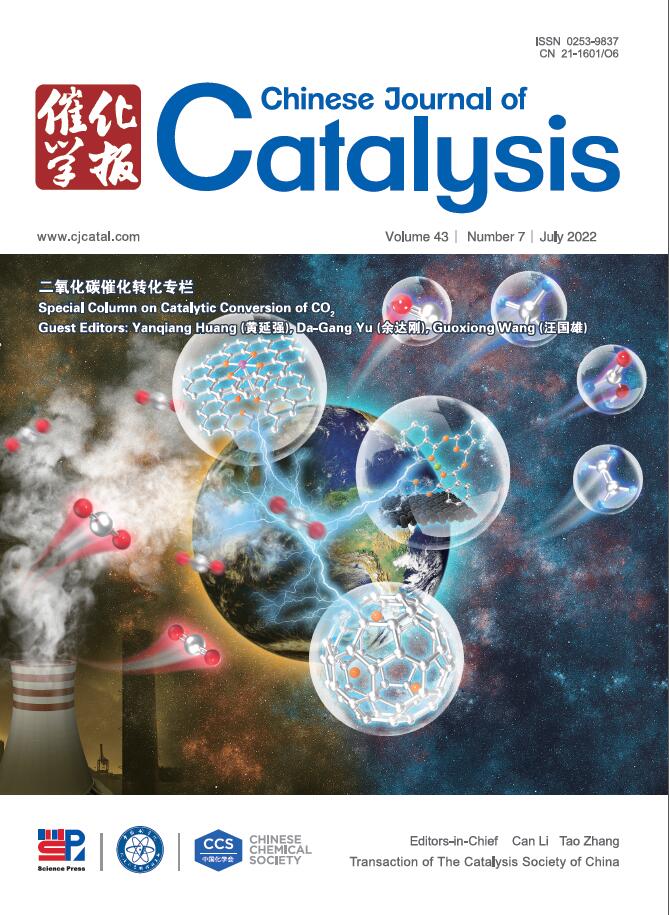Enhancing photocatalytic H2 evolution by weakening S–Had bonds via Co-induced asymmetric electron distribution in NiCoS cocatalysts
IF 17.7
1区 化学
Q1 CHEMISTRY, APPLIED
引用次数: 0
Abstract
The intrinsic symmetrical electron distribution in crystalline metal sulfides usually causes an improper electronic configuration between catalytic S atoms and H intermediates (Had) to form strong S-Had bonds, resulting in a low photocatalytic H2 evolution activity. Herein, a cobalt-induced asymmetric electronic distribution is justified as an effective strategy to optimize the electronic configuration of catalytic S sites in NiCoS cocatalysts for highly active photocatalytic H2 evolution. To this end, Co atoms are uniformly incorporated in NiS nanoparticles to fabricate homogeneous NiCoS cocatalyst on TiO2 surface by a facile photosynthesis strategy. It is revealed that the incorporated Co atoms break the electron distribution symmetry in NiS, thus essentially increasing the electron density of S atoms to form active electron-enriched S(2+δ)– sites. The electron-enriched S(2+δ)– sites could interact with Had via an increased antibonding orbital occupancy, which weakens S–Had bonds for efficient Had adsorption and desorption, endowing the NiCoS cocatalysts with a highly active H2 evolution process. Consequently, the optimized NiCoS/TiO2(1:2) photocatalyst displays the highest H2 production performance, outperforming the NiS/TiO2 and CoS/TiO2 samples by factors of 2.1 and 2.5, respectively. This work provides novel insights on breaking electron distribution symmetry to optimize catalytic efficiency of active sites.
NiCoS共催化剂中co诱导的不对称电子分布减弱S-Had键增强光催化析氢
晶体金属硫化物中固有的对称电子分布通常导致催化S原子与氢中间体(Had)之间的电子构型不正确,形成强S-Had键,导致光催化析氢活性低。在此,钴诱导的不对称电子分布被证明是优化NiCoS共催化剂中催化S位点的电子构型的有效策略,以实现高活性光催化析氢。为此,通过简单的光合作用策略,将Co原子均匀地掺入到NiS纳米颗粒中,在TiO2表面制备均匀的NiCoS助催化剂。结果表明,Co原子的加入打破了NiS中电子分布的对称性,从而增加了S原子的电子密度,形成了活跃的富电子S(2+δ) -位点。富集电子的S(2+δ) -位点可以通过增加反键轨道占用与Had相互作用,从而减弱S - Had键对Had的有效吸附和解吸,使NiCoS共催化剂具有高活性的析氢过程。结果表明,优化后的NiCoS/TiO2(1:2)光催化剂的产氢性能最高,分别是NiS/TiO2和CoS/TiO2样品的2.1和2.5倍。这项工作为打破电子分布对称以优化活性位点的催化效率提供了新的见解。
本文章由计算机程序翻译,如有差异,请以英文原文为准。
求助全文
约1分钟内获得全文
求助全文
来源期刊

Chinese Journal of Catalysis
工程技术-工程:化工
CiteScore
25.80
自引率
10.30%
发文量
235
审稿时长
1.2 months
期刊介绍:
The journal covers a broad scope, encompassing new trends in catalysis for applications in energy production, environmental protection, and the preparation of materials, petroleum chemicals, and fine chemicals. It explores the scientific foundation for preparing and activating catalysts of commercial interest, emphasizing representative models.The focus includes spectroscopic methods for structural characterization, especially in situ techniques, as well as new theoretical methods with practical impact in catalysis and catalytic reactions.The journal delves into the relationship between homogeneous and heterogeneous catalysis and includes theoretical studies on the structure and reactivity of catalysts.Additionally, contributions on photocatalysis, biocatalysis, surface science, and catalysis-related chemical kinetics are welcomed.
 求助内容:
求助内容: 应助结果提醒方式:
应助结果提醒方式:


